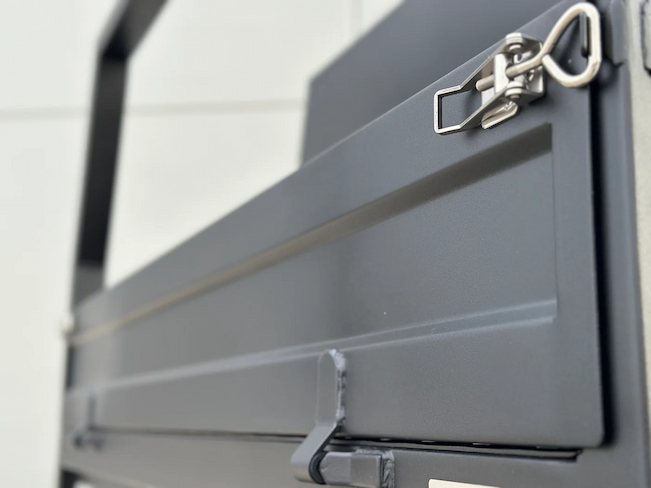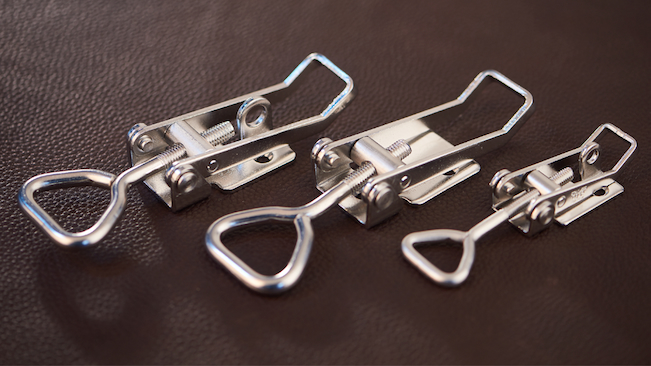It’s easy to understand why adjustable, toggle-style latches are so popular for so many different fastening jobs. Their pivoting, over-the-centre levers allow them to align perfectly every time. And the leverage used to secure the self-locking mechanism itself makes them virtually immovable when engaged.
The fact is, when used within their design limits the mechanical advantages afforded toggle-style latches allow them to multiply their basic holding force by as much as 10x. That’s why they’re the preferred fasteners for everything from ute toolboxes to boat hatches. And with their low acquisition and maintenance cost, it’s no wonder that they’re favoured by businesses and industries that use them by the thousands.
Sticking to the Basics With Unbreakable Over Centre Fasteners

Let’s be honest: while conversations about pivots, levers and leverage may sound more like a basic science lesson from high school than a discussion about fasteners, the reality is the strength and dependability of overcentre latch assemblies come from sticking to the basics. Toggle-style latches are recognised as secure, easy to release fastening solutions that are as resistant to unwanted prying and spreading as they are to incidental shock or vibration.
The latch’s design stipulates that unless the mounting surface is compromised, only a force equal to or greater than the assembly’s clamping force can open the latch. And as the heaviest duty versions of these latches are capable of capacities as high as 7000kg UTS (ultimate tensile strength), they themselves are a force to be reckoned with.
Simplicity, not mass, is the key to designing over centre latches that are effective. And it’s from their simplicity that they derive their most critical traits, which includes:
- Uncompromised strength where it matters. With their threaded toggles and range of small or large sizes, over centre latch assemblies typically offer an adjustment range between 10mm – 20mm, and can be calibrated to produce the exact amount of clamping force needed to hold any door or panel firmly in position until the latch is released.
- Uncompromised reliability when it matters. Toggle-style latches consist of only a toggle lever, a hook (latch) and a sturdy pivot. With regular inspections of the over centre mechanism and its fastening points, the assembly’s inherent simplicity guarantees maximum reliability.
- Unmatched durability because it matters. Durability is the key to reliability, and both high tensile zinc plated mild steel and high nickel content 304- or 316-grade stainless steel overcentre latch assemblies provide the exact amount of strength and rust and corrosion resistance that’s needed to withstand the most stressful conditions, either indoors or outdoors.
Between their zero-maintenance design, superior strength and resilience, and all round unbeatable cost, it’s no wonder that over centre latch hook assemblies are the vibration-proof fasteners of choice for the mining and heavy machinery industries, as well as for the telco and aerospace sectors. They’re proof that latches and fasteners don’t have to be over-engineered to be unbreakable.
Padlockable Latches Designed to Take Security Seriously
While simplicity, ease of fastening and vibration-resistant closures are the trademarks of heavy duty over centre latch assemblies, they lack for nothing when it comes to physical security. Toggle-style overcentre latches are used on everything from fixed-site HVAC and generator enclosures, to mobile commercial and recreational vehicles, and they demand protection from malicious damage and theft.
There are two primary types of toggle-style, over centre fasteners available in Australia that are especially well-suited for the security function. And it’s no coincidence that they’re also the two with the most straightforward design, which are:
- Padlockable over centre fasteners. These standard, adjustable over centre fastener assemblies are manufactured in a range of sizes and are fitted with padlockable hasp holes in their baseplates.
- Toggle handle over centre fasteners. These flat-handled fasteners are designed with adjustable push/pull-type toggle handles that can be rapidly opened or closed and are also fitted with padlockable hasp baseplates.
Make no mistake: while there are more than ten different styles of over centre-type fasteners in regular production, these mild steel and stainless over centre latch assemblies are the toughest, simplest and ultimately the most cost-effective way to secure equipment and assets, especially when it comes to:
- Long term storage of fixed-site equipment and assets that don’t need to be accessed too often;
- Transporting goods and materials that aren’t readily accessible or visible at all times;
- Transporting goods and materials that are dangerous or hazardous and require exceptional storage procedures;
- Movement and handling of high value materials, or materials stored specifically in tamper-evident closures; and,
- Environments where there’s an increased likelihood of the closure being tampered with or broken into.
It’s important to remember too that no matter how durable a fastener assembly is, the equipment and assets being stored are still only as secure as the door of the closure itself. That’s why anytime a toggle-style latch is being contemplated, consideration also has to be given to where and how it’s mounted.
Mounting Surfaces Make the Difference in Latch Reliability

There’s no way around it: even though there’s no substitute for the reliability and cost efficiency of a well-design toggle latch, a fastener is still only as reliable as the surfaces it’s mounted to. And as everything from temperature extremes to concussive impacts can affect the amount of tension and holding force a latch needs to withstand, every facet of where and how the fastener is mounted needs to be scrutinised, including:
- The state of the mounting surfaces. Metal doors and panels like the ones found on shipping containers and ute boxes are ideal for mounting toggle-style latches. However, mounting surfaces that are prone to weakening due to moisture and environmental factors may require reinforcing before mounting a heavy duty latch.
- The integrity of the mounting hardware. While plated and stainless steel latches are designed specifically to resist rust and corrosion, the screws and hardware holding the latches may not be. That’s why the strength and integrity of the mounting hardware needs to match the durability of the latch.
- Convenience and ease of access. Convenience is a critical part of any latch’s installation, which is why care needs to be taken to ensure that the placement of the latch doesn’t interfere with how easily it can be engaged or released, especially if access to the closure is required to be kept clear.
And while mounting more latches on sturdier doors and panels may seem like a logical way to compensate for other closure problems, it’s an approach that can actually lead to more problems than it resolves. That’s because installing an excessive number of latches creates unnecessary complexity while also increasing the number of points of possible failure.
With multiple latches mounted, the gripping tension created by even one latch becoming misaligned or being out of adjustment is enough to distort the mounting surface, or cause the remaining latches to disengage or fail entirely. It underlines the importance of ensuring that the latches and mounting surfaces are conducive to the job that needs to be done.
The Final Word
At the end of the day, the reliability and rigid simplicity of toggle-style latches makes them suitable for a virtually limitless range of fastening duties. And with one of the lowest repair and maintenance ratios of any type of industrial-grade latching assembly, they’re a solution with a deployment cost that actually drops as more assemblies are installed.
Regardless of whether it’s for a single ute tray toolbox or a factory full of high voltage utility boxes, overcentre assemblies are among the best fastener investments that can be made. They’re proof that when it comes to security, sticking to the basics works every time.
























